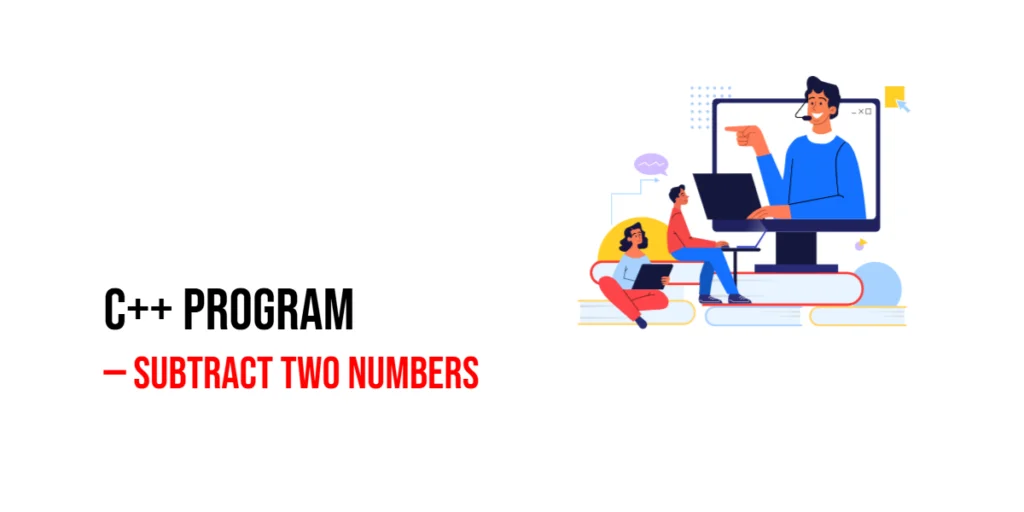Learning C++ opens the door to countless programming opportunities, and one of the simplest yet most important tasks is subtracting numbers. Subtraction is a fundamental arithmetic operation used in everything from basic calculators to financial applications and games. Writing a C++ program to subtract two numbers helps beginners understand variables, input/output, and basic arithmetic operations. This makes it a perfect starting point for anyone new to programming.

with hands-on learning.
get the skills and confidence to land your next move.
Program 1: Subtract Two Numbers Entered by the User
This program takes two numbers from the user and calculates their difference, teaching beginners how to handle input and perform subtraction.
#include <iostream>
using namespace std;
int main() {
int num1, num2, difference;
cout << "Enter the first number: " << endl;
cin >> num1;
cout << "Enter the second number: " << endl;
cin >> num2;
difference = num1 - num2;
cout << "The difference between " << num1 << " and " << num2 << " is " << difference << endl;
return 0;
}In this program, the user enters two numbers, which are stored in the variables num1 and num2. The program calculates the difference and displays the result. This is useful for beginners to practice working with variables, user input, and arithmetic operations. Understanding this basic subtraction logic lays the groundwork for more complex calculations later.
Program 2: Subtract Two Numbers Using a Function
This program demonstrates how to use a function to subtract two numbers, which organizes the code and makes it reusable.
#include <iostream>
using namespace std;
int subtractNumbers(int a, int b) {
return a - b;
}
int main() {
int num1, num2;
cout << "Enter the first number: " << endl;
cin >> num1;
cout << "Enter the second number: " << endl;
cin >> num2;
int difference = subtractNumbers(num1, num2);
cout << "The difference between " << num1 << " and " << num2 << " is " << difference << endl;
return 0;
}Here, the subtraction is done inside a function called subtractNumbers. This makes the code cleaner and demonstrates the importance of reusable functions. Beginners can learn how to define functions and call them, which is essential for writing larger programs efficiently.
Program 3: Subtract Decimal Numbers
This program shows how to subtract decimal numbers using double variables, which is useful when precise values are needed.
#include <iostream>
using namespace std;
int main() {
double num1, num2, difference;
cout << "Enter the first number: " << endl;
cin >> num1;
cout << "Enter the second number: " << endl;
cin >> num2;
difference = num1 - num2;
cout << "The difference between " << num1 << " and " << num2 << " is " << difference << endl;
return 0;
}This program is similar to Program 1, but it uses double variables to handle decimals. Beginners learn how changing the data type allows the program to work with fractional numbers. This is important in applications like financial calculations where precision matters.
Program 4: Subtract Two Numbers Without User Input
This program subtracts numbers defined directly in the code, making it simpler for beginners to focus on subtraction logic.
#include <iostream>
using namespace std;
int main() {
int num1 = 50;
int num2 = 20;
int difference = num1 - num2;
cout << "The difference between " << num1 << " and " << num2 << " is " << difference << endl;
return 0;
}In this version, the numbers are assigned directly to variables. The program calculates the difference and displays it immediately. This approach allows beginners to focus on understanding the subtraction operation without worrying about user input.
Program 5: Subtract Numbers Directly Without Variables
This program subtracts two numbers directly and displays the result, showing subtraction in the simplest form.
#include <iostream>
using namespace std;
int main() {
cout << "The difference between 10 and 5 is " << 10 - 5 << endl;
return 0;
}Here, 10 and 5 are subtracted directly in the cout statement. No variables are used, so the result appears immediately. This is perfect for beginners to see subtraction in action without additional complexity.
Program 6: Subtract Numbers Stored in Variables Without Storing Difference
This program stores numbers in variables but calculates and displays the difference directly, helping beginners work with variables.
#include <iostream>
using namespace std;
int main() {
int num1 = 20;
int num2 = 8;
cout << "The difference between " << num1 << " and " << num2 << " is " << num1 - num2 << endl;
return 0;
}In this program, num1 and num2 hold the numbers, but the difference isn’t stored in a separate variable. Subtraction happens directly inside the cout statement, teaching beginners that storing results in a separate variable is optional for simple calculations.
Program 7: Subtract Numbers with One Stored in a Variable and One Direct
This program demonstrates how to subtract a number used directly from a number stored in a variable, showing flexibility in subtraction operations.
#include <iostream>
using namespace std;
int main() {
int num1 = 15;
cout << "The difference between " << num1 << " and 5 is " << num1 - 5 << endl;
return 0;
}In this program, num1 holds one number, while 5 is used directly in the subtraction. The difference is calculated inside the cout statement without storing it in a separate variable. This teaches beginners that you can mix variables and direct values in subtraction, keeping the code simple and easy to read.
Program 8: Subtract More Than Two Numbers
This program shows how to subtract more than two numbers in sequence, helping beginners understand how subtraction works with multiple values.
#include <iostream>
using namespace std;
int main() {
int num1 = 100;
int num2 = 20;
int num3 = 15;
int difference;
difference = num1 - num2 - num3;
cout << "The result of subtracting " << num2 << " and " << num3 << " from " << num1 << " is " << difference << endl;
return 0;
}In this program, we subtract more than two numbers by chaining the subtraction operation. The value of num1 is reduced first by num2 and then by num3, and the final result is displayed. This teaches beginners how subtraction can be extended beyond just two numbers, and it helps build understanding of how operations are performed sequentially in C++. You can try adding more numbers to see how the result changes, which is excellent practice for learning arithmetic operations in C++.
Frequently Asked Questions (FAQ)
This section answers common questions beginners have about subtracting numbers in C++, helping clarify doubts and reinforce learning.
Q1: What is a variable in C++?
A variable stores data in your program. For example, num1 and num2 hold numbers in our subtraction programs. Each variable has a type, like int for whole numbers or double for decimals.
Q2: Can I subtract more than two numbers?
Yes! You can subtract multiple numbers using more variables, arrays, or loops to automate calculations for several values, as shown in Program 8.
Q3: What happens if I subtract a decimal number from an integer?
C++ converts the integer to a decimal temporarily for the calculation. For example, subtracting 2.5 from 5 results in 2.5.
Q4: Why use functions for subtraction?
Functions make code organized and reusable. You can perform subtraction in a function and call it multiple times without rewriting code.
Q5: Can these programs run without a computer?
No. A C++ compiler like Code::Blocks, Visual Studio, or online IDEs is needed to execute the code.
Q6: What are common beginner mistakes?
Beginners may use the wrong data type, forget cin for input, or miswrite cout for output. Testing the program step by step helps identify these errors.
Conclusion
Subtracting numbers in C++ may be simple, but it introduces key concepts like variables, data types, arithmetic operations, input/output, functions, arrays, and loops. Practicing these programs helps beginners build a strong foundation and prepares them for more complex programming tasks. Experimenting with the code and making small modifications is the best way to learn and improve your skills.
Additional & References
For beginners who want to continue learning and practicing, the following resources are highly recommended:
- C++ Documentation – Detailed reference for syntax, functions, and data types.
- TutorialsPoint C++ Tutorial – Beginner-friendly tutorials with step-by-step examples.
- GeeksforGeeks C++ Guide – Offers practical tips, code snippets, and explanations to reinforce learning.







